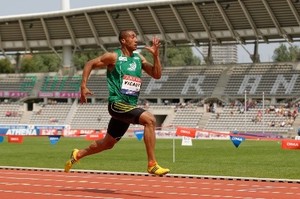12/14/2021
Sports Nutrition for Peak Performance
By Mike Feld, ATC, CSCS, PES, Oyster River High School Athletic Trainer
As coaches and athletes prepare for off-season, pre-season, or in season training sessions, the focus tends to be on things you can see and measure. What exercises can we do to get bigger, stronger, and faster? What exercises will make me jump higher or throw harder? How much can I bench press, squat or deadlift? While these are all good questions to ask and good goals to have, it leaves out one very important question: Where am I going to get the energy to achieve all these desired training outcomes? The nutritional aspect of any athlete’s training program may be the most overlooked; yet is one of the most important components to the success of the program. This analogy has been made many times before; but think of your body like a car - you can have the newest and shiniest model on the market, but if you aren’t putting the proper fuel in the car, you won’t be going anywhere.


The idea of proper sports nutrition can often seem like a very complicated equation, especially when we are talking about elite level professional athletes. In reality; at its root, fueling your body properly can be very simple. Your body receives energy, in the form of calories, from 3 sources known as macronutrients. These three energy sources are carbohydrates, protein, and fat.
Carbohydrates
There are 4 calories in every gram of carbohydrates and is the primary source of fuel for our muscles. There are many different forms of carbohydrates, but the two most heard terms are glucose and glycogen. Glucose is a simple form of carbohydrate that is easily broken down in the body and used for energy. Glycogen is simply glucose that is stored in the body, mostly in the liver and muscles. Glycogen is turned into glucose when energy is needed in the muscles. Failing to maintain an adequate level of stored up glucose that can be readily delivered to the muscles results in that feeling of muscle fatigue or “hitting the wall”. The higher the level of intensity of the exercise the more your body relies on carbohydrates for energy. At a full out sprint your body relies on carbohydrates for 90% of the calories burned. At a lower intensity exercise, like walking, only 50% of the calories burned come from carbs. Roughly 60% of your caloric intake should come from carbohydrates. Some good sources of carbohydrates include:
- Fruits
- Vegetables
- Low fat yogurt
- Oatmeal
- Bagels
- Cereal (NOT one with marshmallows!)
- Pastas
- Beans
- Nuts
Protein
Many athletes have the misconception that protein is the most important nutrient for fueling athletic performance and that more is better. This is not necessarily the case. Protein consumption is no more or less important than carbohydrate or fat consumption. Like carbohydrates, there are 4 calories in every gram of protein. Unlike carbohydrates, the main function of protein in the body is not as a main energy source. Proteins are the building block of muscle and are a vital component to the growing and repairing of muscle. Roughly 15% or your caloric intake should come from protein. Some good sources of protein are:
- Chicken
- Grass-fed beef
- Wild caught fish
- Eggs
- Almonds
- Greek Yogurt
- Nut butters
- Quinoa
Fat
Yes, athletes need to consume fat! Fat is a very highly-concentrated source of energy and provides more than double the calories per gram than either protein or carbohydrates. Fats contain 9 calories per gram and should constitute about 25% or your caloric intake. Due to its high energy/calorie content, incorporating fats into your diet allows you to consume a smaller volume of food while still meeting your caloric needs. Some sources of good healthy fats include:
- Whole milk yogurt
- Fatty fish (salmon, tuna, trout, cod)
- Peanut butter
- Avocado
- Cheese
- Whole eggs
- Seeds (sunflower, pumpkin, sesame)
Managing the intake of calories can become quite the balancing act and it is important to remember that more does not always mean better. An increase in the amount of one nutrient can lead to a deficiency in another. For example, if you significantly increase the calories you are ingesting in the form of protein then you may be decreasing the amount of carbohydrates you are ingesting. By decreasing your carbohydrate intake, you will decrease the amount of glucose in the blood as well as the stored glycogen which are the body’s readily available sources of energy. Once the level of glucose and glycogen stores become too low your body will start burning protein calories for energy. Since protein is the main component in muscle growth and repair, using protein as a main source of energy will have a significant effect on your body’s ability to recover from a training session or competition.
Nutrient Timing
It is incredibly important to make sure that you are not only eating the proper foods to fuel your body both before and after activity but that you are also eating the proper things at the right time. Here are some suggestions of what you could be eating in the hours leading up to and immediately following your event.
4+ hours before:
- Pasta and meat sauce
- Pasta/chicken/veggies
- Grilled chicken/rice/fruit
- tuna sandwich
- trail mix w/nuts and raisins
- Turkey sandwich w/baby carrots
2-3 hours before:
- Cereal w/1%milk
- Bagel w/peanut butter
- Fruit Smoothie
- Oatmeal
- Fresh Fruit
- Greek Yogurt
1 hour before:
- Granola Bar
- Pretzels
- Dried Fruit
- Sports Drink
- Banana
- Cereal bar
Post Exercise
Following activity, it is very important to start refueling as soon as possible to allow your body the opportunity to begin to build up its glucose and glycogen stores. Within the first 15 minutes after the completion of your activity is the best time to try to consume a snack with somewhere between 200-400 calories from carbohydrates. It is also recommended to take in about 20g of protein as well. This will stimulate the body to begin the process of rebuilding and repairing damaged muscle as well as storing up energy. Some post activity snack recommendations include:
- Fruit and non-fat yogurt
- Trail mix
- Banana w/peanut butter
- Chocolate milk(low fat)
- Pita bread with hummus
Navigating the world of sports nutrition can seem like a daunting task sometimes. It is not something that you have to try to figure out on your own. Consulting with a nutritionist who has experience working with athletes or talking with your own high school athletic trainer can be a good start in the right direction to eating in a way that fuels your body for maximum athletic performance.
 Mike Feld is a Certified Athletic Trainer through the Nation Athletic Trainers Association. He is also certified through the National Strength and Conditioning Association as a Strength and Conditioning Specialist as well as a Performance Enhancement Specialist. Mike graduated from Endicott College with a BS degree with a focus on Athletic Training. He has served as the Head Athletic Trainer for Oyster River High School for just over 19 years as well as coordinating the off-season conditioning programs for many of their sports programs. Throughout his career as an Athletic Trainer and a Strength Coach, Mike has worked with athletes ranging from middle school, to high school, to professional-level athletes. Mike also spends time working in the Center for Athletes working with athletes as well as post-rehab clients helping them reach their performance goals.
Mike Feld is a Certified Athletic Trainer through the Nation Athletic Trainers Association. He is also certified through the National Strength and Conditioning Association as a Strength and Conditioning Specialist as well as a Performance Enhancement Specialist. Mike graduated from Endicott College with a BS degree with a focus on Athletic Training. He has served as the Head Athletic Trainer for Oyster River High School for just over 19 years as well as coordinating the off-season conditioning programs for many of their sports programs. Throughout his career as an Athletic Trainer and a Strength Coach, Mike has worked with athletes ranging from middle school, to high school, to professional-level athletes. Mike also spends time working in the Center for Athletes working with athletes as well as post-rehab clients helping them reach their performance goals.